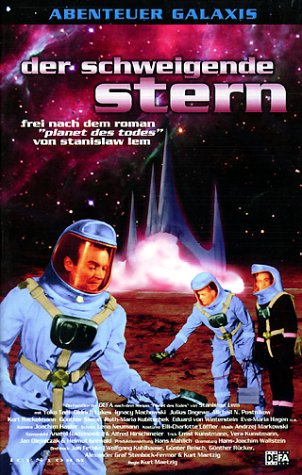Previous FilmFirst Men in the Moon
Next FilmFive
First Spaceship On Venus 1959
 | When an alien artifact discovered on Earth is found to have come from Venus, an international team of astronauts embarks to investigate its origins. |
The Cast
| Yôko Tani | - | Die japanische Ärztin |
| Oldrich Lukes | - | Amerikanischer Atomphysiker |
| Ignacy Machowski | - | Polnischer Chefingenieur / |
| Julius Ongewe | - | Afrikanischer Fernsehtechniker / |
| Michail N. Postnikow | - | Sowjetischer Astronaut / |
| Kurt Rackelmann | - | Indischer Mathematiker / |
| Günther Simon | - | Deutscher Pilot |
| Hua-Ta Tang | - | Chinesischer Linguist / |
Film Trivia
In the original German version, "Brinkman(n)" isn't American but East German, and the "Durand" character is a Soviet cosmonaut by the name of "Prof. Arsenjew" (Arsenyev), "the man who steered the first rocket to the moon"!
The film takes place in 1985.
In the 1962 USA release version, on the film soundtrack, in a scene in the control room of the Kosmostrator rocket, we hear a music track titled "In Outer Space" from Destination Moon (1950) by Leith Stevens, and later in the movie, in the scenes of eerie destruction of the Venusian city, we hear a music track titled "Metaluna Catastrophe" from This Island Earth (1955) by Herman Stein. Both of these uses of music were uncredited and unlicensed, and unauthorized by the copyright holders.
Although it was a co-production with a Polish company, it was still the most expensive production for DEFA up to that time.
The writing process involved 3 writing teams and 12 screenplays before a final script was acceptable to the studio and the government.
This was meant to be a high-profile release by DEFA for the 10th anniversary of the German Democratic Republic (East Germany).
During principal photography, the first English Film Festival was being held in Berlin. Various British film dignitaries were brought to DEFA to meet the director, Prof. Kurt Maetzig, and watch as some scenes were being shot.
The German version contains a reference to one of the professors having his career stalled when he was thrown out of the university by the Nazis. Director and co-writer Kurt Maetzig had his career stalled by the Nazis because his mother was Jewish.
In the US version of this film, several pieces of music from the The Wolf Man (1941) can be heard in multiple scenes throughout the movie.
This large scale East German-Polish co-production was the first to be shot in the Totalvision widescreen process.
At one point DEFA intended to establish a co-production with a French company for financing and scriptwriting. Part of the plan was to use French actors Yves Montand and Simone Signoret. However, Communist government officials disapproved of DEFA's pursuit of Western partners.
This film was based on Stanislaw Lem's 1951 novel "Astronauci" ("The Astronauts"). This was Lem's first novel and, to get is published, he had to insert some pro-communist elements. The pro-communist elements of the book contributed to the government's approval for this expensive and high- profile production by DEFA. The communist elements were minimized in the film.
In the U.S., this was distributed in an edited and English dubbed version as "First Spaceship on Venus" through Crown International. It was at the top of a prepackaged double feature with "Varan the Unbelievable." It became Crown International's most successful double feature since, unlike other Crown International releases, it was booked into many theaters as well as drive-ins.
In the original German and Polish version, the spaceship was called the Kosmokrator. In the English dubbed version released as "First Spaceship on Venus," it is called the Cosmostrator.